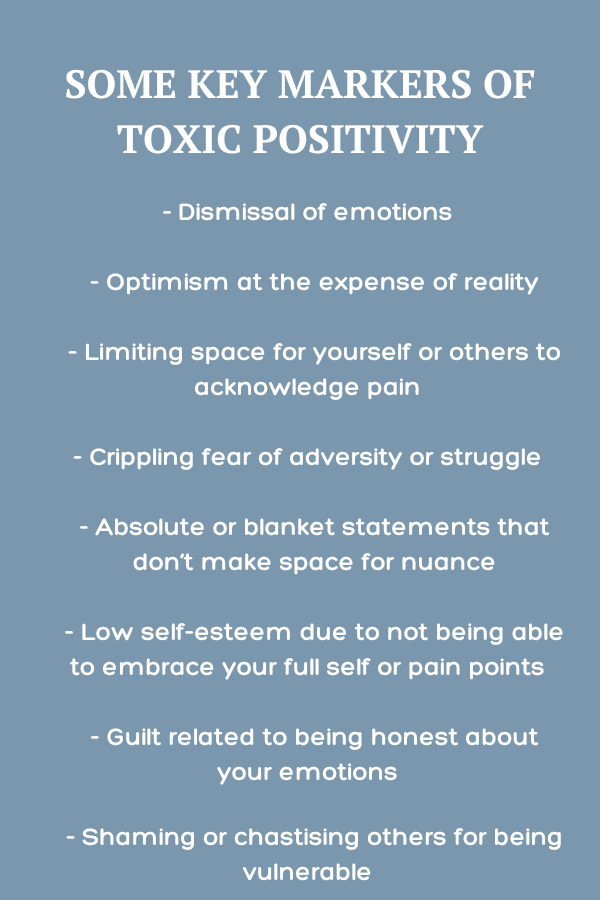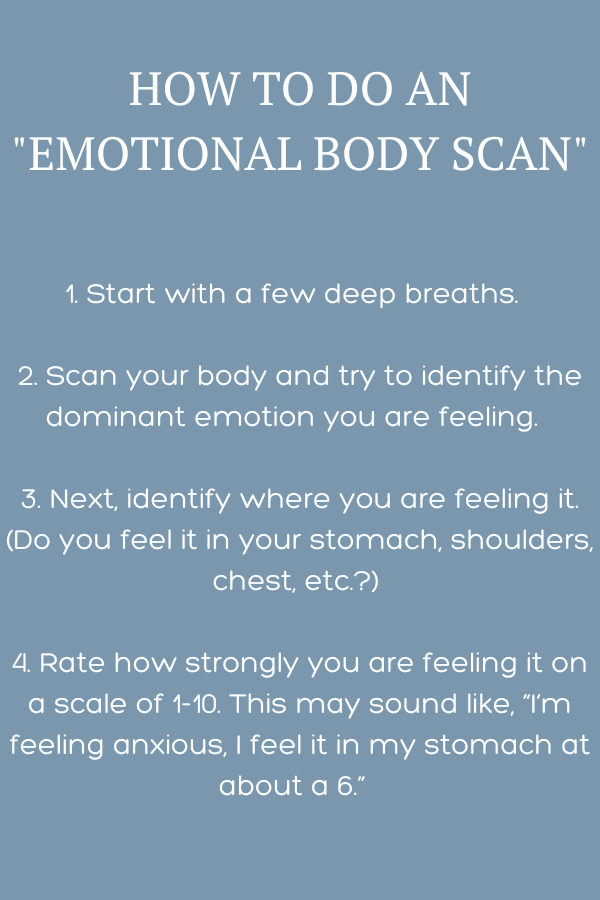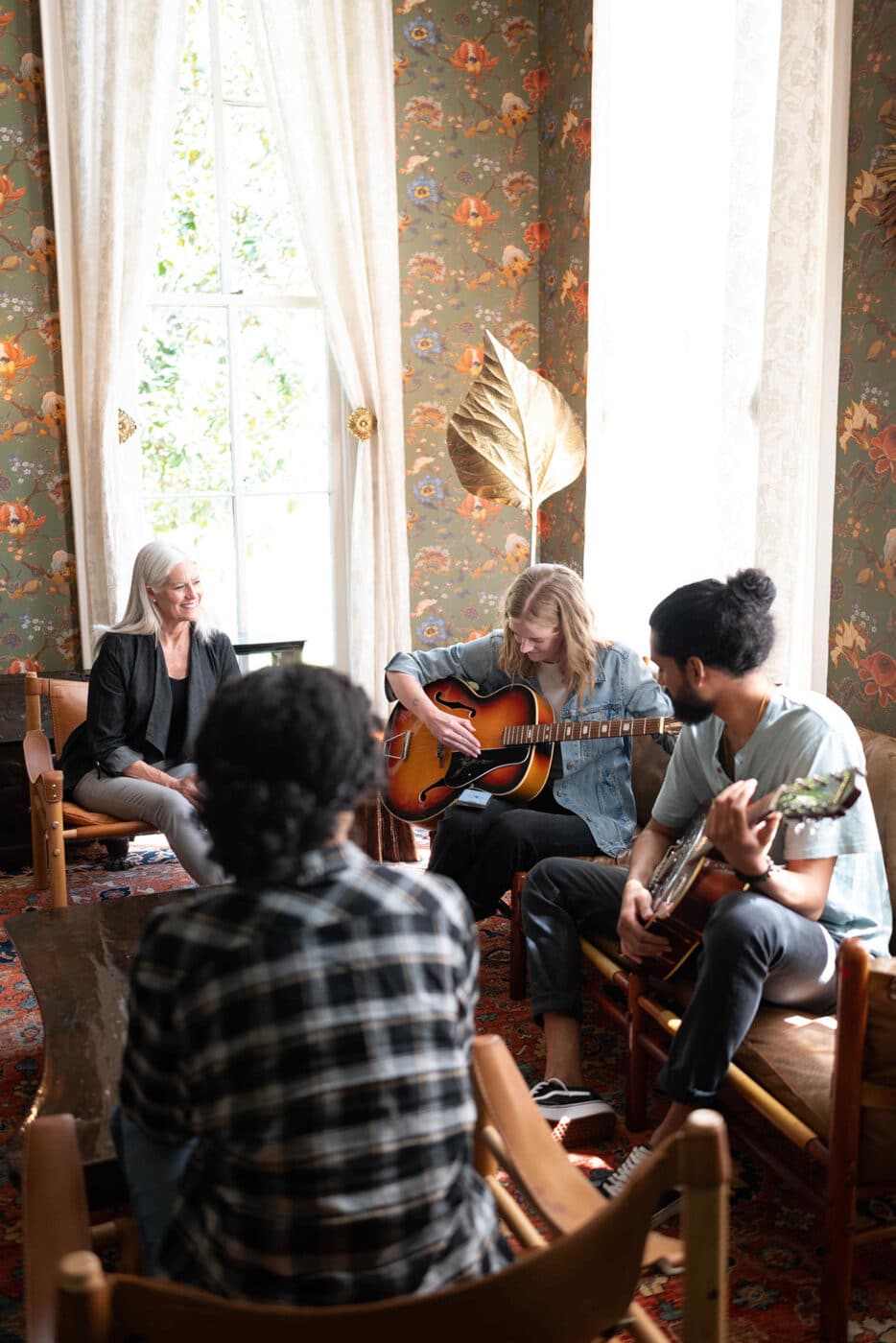Could Your Positivity Be ‘Toxic’?
Originally posted in collaboration with StyleBlueprint.
It’s often said that positivity is a mindset that can change everything. Letting go of negativity and adopting a positive approach is the best way forward, right? Countless motivational quotes and self-help books suggest that to succeed in our careers, rebound from failures, create a happier home life, and maintain our mental health, we must always embrace optimism — the key to happiness. Turns out, it’s not that simple.
Today, experts are widely recognizing that an obsession with positivity can actually become a roadblock to healing and growth, as it can cause us to suppress our emotions and even invalidate the emotions of others. We consulted the team at Onsite for insight into the concept of “toxic positivity,” how to recognize it, and what we can do to strike a better balance.
What is toxic positivity?
According to Psychology Today, “Toxic positivity is the act of avoiding, suppressing or rejecting negative emotions or experiences. This may take the form of denying your own emotions or someone else denying your emotions, insisting on positive thinking instead.”
When someone asks, “How are you?” Do you respond with “I’m great!” even if you’re miserable? Do you stick to posting only your happiest moments on social media, even during a season of emotional upheaval? At first glance, these instances may pass themselves off as harmless optimism or a layer of privacy. But false or forced positivity can actually be a form of gaslighting, causing you to question your reality. With so much societal emphasis on putting a positive spin on challenges that come our way, we might find ourselves glossing over our emotions in the name of peacemaking or people-pleasing.
It’s all about finding balance — a happy medium where you don’t fall into a pattern of negativity or hide behind a facade of positivity. A space where you embrace your truth while remaining hopeful. Mickenzie Vought, Onsite’s Editorial and Community Director, says, “Positivity is only toxic when it causes us to deny, dismiss, disengage, or diminish our reality and true emotions.”
Where does toxic positivity come from?
Believe it or not, toxic positivity is often rooted in how emotions are handled during childhood. Many of us grew up in homes that placed rules on managing our emotions. For example, you may have been told, “That’s not something to cry about,” or it may have been made clear that anger was a “bad” emotion, while joy and happiness are “good” ones.
“Many of us grew up in homes that taught us very clear (whether explicit or not) rules or narratives about our emotions,” says Laurel Powell, Clinical Coordinator Manager at Onsite. “If you were not taught to fully embrace our wide breadth of emotions — or worse, you were taught to dismiss or diminish certain emotions — you might have grown up with the inability to express and interrupt what you’re actually feeling. When that is the case, it can feel easier to dismiss what you’re feeling and lean into toxic positivity.”
Those early narratives become an integral part of our psychological fabric, making it tougher to recognize when there’s an emotional disconnect in adulthood. “Many of us are extremely disconnected from our internal worlds,” Laurel tells us. “When this happens, we become disengaged from our emotions. If you didn’t learn to connect to your internal world in your early years, it’s hard to know where to start when it comes to connecting with what’s going on inside your heart and mind. It takes intentional effort and often the unraveling of narratives and false beliefs you hold around emotions. Additionally, you can only offer to others what you offer to yourself. If you are more comfortable denying your own emotions, you will not be capable of holding space for the people in your life when they share something hard. Toxic positivity is often more harmful when we use it to manage our discomfort and disengage from our loved ones when they are struggling.”
It’s also worth noting that social media contributes to a culture of toxic positivity, giving us a platform to create a curated image and compare ourselves to others who are doing the same. “There is no denying the impact of social media when it comes to the prevalence of toxic positivity,” says Laurel. “Every day, we scroll through an ecosystem designed to make us feel bad about ourselves. Algorithms keep us locked in on images of others presenting their ‘best selves.’ Social media is almost averse to true vulnerability. We only share the best parts of our lives. Social media causes us to compare our internal worst to other people’s external best. Comparison is the thief of joy and a perpetrator of toxic positivity.”
Key Markers of Toxic Positivity
While the line between ‘productive’ versus ‘toxic’ positivity may not always be easy to spot, there are some telltale signs. The following phrases often accompany toxic positivity:
- “It could be so much worse.”
- “Don’t be so negative.”
- “Just look on the bright side.”
- “Just think happy thoughts.”
- “Everything happens for a reason.”
Additionally, here are some key markers regarding the presence of toxic positivity
Repercussions of ‘Too Much’ Positivity
If you’ve identified an emotional disconnect, the next step is asking yourself if you’re numbing your pain. Are you masquerading behind positivity? And if so, are you stifling your emotions such that you’re not only procrastinating grief and anger but true joy, too? “We can’t selectively numb our emotions,” Laurel says. “If we numb pain, we ultimately numb joy. Wholehearted living is only available to those who are willing to embrace every experience life has to offer. At Onsite, we sometimes say that if we don’t deal with our emotions, they will deal with us — usually in unhealthy and unproductive ways.”
Laurel goes on to say that the most detrimental repercussion of too much positivity is the breakdown of community, resulting in isolation and a lack of genuine connection. “In an attempt to create a positive situation, those who love this person can feel gaslit and invalidated,” she tells us. “True engagement and community cannot take place in a shaming or critical environment.”
Additionally, research suggests that those who suffer from low self-esteem may feel even worse if they practice positive affirmations they don’t actually believe, such as “I am brave” or “I am deserving.” Moreover, those same study subjects discovered that their moods improved when they were given “permission” to experience negative thoughts. “When we create space to acknowledge what we’re feeling instead of blindly denying our pain or struggle, it has a positive impact on our overall feelings and outlook,” offers Laurel.
How can we strike the right balance?
Perception might be the key to finding the emotional balance we’re searching for. The team at Onsite refers to emotions as information, suggesting that if we can view our feelings simply as a method of delivering information, we can begin to see just how useful all of our emotions can be — even the most uncomfortable ones. “If we’re willing to get curious, each of our emotions offers us a gift and invitation that will serve us in every area of our lives,” offers Laurel. Sometimes, avoiding toxic positivity is a result of naming our feelings. Naming our feelings can sound like:
- “This is hard.”
- “I want to be optimistic, but I’m struggling right now.”
- “I’m afraid that …”
- “Today I’m feeling … and I feel it in my …”
- “This makes me feel both sad and glad.”
“Sometimes simply taking space and time to get curious about what we’re feeling can counteract our well-worn instincts to immediately reframe or dismiss uncomfortable emotions,” says Mickenzie. “Our feelings are often thought to live in our heads and hearts, but they show up in our bodies too. For instance, maybe you feel anxiety as an ache in your gut, or maybe you feel gratitude as warmth in your heart. Doing an ‘Emotional Body Scan’ can be a helpful tool to turn your attention towards your body and connect with your emotions in a way that grounds you.”
If you’re looking for outlets to help mitigate toxic positivity, there are several options for practical assistance. Journaling, for example, can help you explore your feelings in a private yet productive way. A few prompts to use when writing might be, “What do I want?” “What hurts right now?” “What am I grateful for?” and “Where do I see beauty around me?”
If you’re open to sharing your feelings with someone, choose a friend, family member, or professional who offers a safe, non-judgmental space. “We all deserve to be seen, heard, and valued,” says Mickenzie. “Sharing our experiences is a beautiful gift we can give ourselves and others. It can also open us up to exploration, insight, and understanding into ourselves that we cannot find in isolation. Other people have a way of serving as a mirror for us … It is incredibly painful when we open up to someone and are met with dismissing or diminishing statements. It leaves us feeling unsafe, unseen, and devalued. It may cause us to diminish our own pain, stuff our feelings, or think twice before sharing with someone in the future. The reality is that when people are unwilling to engage with themselves, they cannot engage with our hard emotions or experiences. People who meet us with toxic positivity are likely uncomfortable with emotions they associate as negative or difficult.”
And while there is no right or wrong when it comes to our feelings, beware of overcompensation — the trick is finding balance. “It is less about getting it right and more about simply being a noticer,” says Laurel. “When we can acknowledge the reality of what we’re feeling and experiencing, we experience the full breadth of all that life has to offer — good, bad, neutral, and everything in between. It is important to recognize that intense negative emotions often coincide with equally powerful positive emotions. Allow yourself to recognize and embrace that various emotions can occur simultaneously.”
If you are looking to further your emotional knowledge and self-awareness, you may want to consider an Onsite program or workshop like “Becoming Emotionally Smart,” which explores how to unlock your emotions for a more connected life.


















